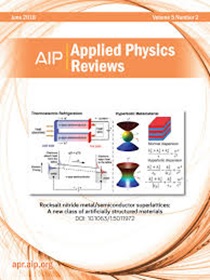Ultra-wide and self-powered WSe2/4H-SiC hybrid-dimensional heterojunction photodetector with rapid response toward multifunctional applications
IF 11.6
1区 物理与天体物理
Q1 PHYSICS, APPLIED
引用次数: 0
Abstract
Broadband self-powered photodetectors have attracted great attention owing to their capacity to detect a wide range of wavelengths and save energy. However, the majority of existing broadband photodetectors are limited in their detection range by the material bandgap, making it difficult to achieve detection from ultraviolet to infrared wavelength, and the response performance is not uniform for each waveband. Additionally, a significant disparity persists between self-powered photodetectors and conventional semiconductor photodetectors with regard to pivotal photodetection parameters, such as responsivity. To address these problems, a broadband self-powered photodetector based on two-dimensional WSe2/three-dimensional 4H-SiC heterojunction is proposed. The wide bandgap of 4H-SiC and the narrow bandgap of WSe2, in conjunction with the built-in electric field of the heterojunction and the metal/semiconductor interface, enable the device to detect light from 200 to 1100 nm and achieve a uniform high-performance response to the ultraviolet, visible, and infrared wavelengths simultaneously. Under 275 nm illumination (Vds = −1 V), the device demonstrates a responsivity and detectivity of 25.7 A/W and 3.85 × 1012 Jones, respectively, and exhibits an ultra-fast rise/decay time of 42/42 μs under 635 nm illumination (Vds = −1 V). Moreover, under Vds = 0 V and 635 nm illumination, the responsivity and detectivity of the device are 1.22 A/W and 2.67 × 1011 Jones, respectively. The device exhibits great capability in high-performance, broadband, self-powered light detection, providing a new direction for the development of next-generation energy-saving, high-sensitivity optoelectronic integration technology.具有快速响应的超宽自供电WSe2/4H-SiC混合维异质结光电探测器,面向多功能应用
宽频带自供电光电探测器由于能够探测大范围波长和节省能量而受到广泛关注。然而,现有的大多数宽带光电探测器的探测范围受到材料带隙的限制,难以实现从紫外到红外波段的探测,并且每个波段的响应性能不均匀。此外,自供电光电探测器和传统半导体光电探测器之间在关键的光电探测参数(如响应性)方面存在显著差异。为了解决这些问题,提出了一种基于二维WSe2/三维4H-SiC异质结的宽带自供电光电探测器。4H-SiC的宽带隙和WSe2的窄带隙,结合异质结和金属/半导体界面的内置电场,使器件能够检测200至1100nm的光,并同时实现对紫外、可见光和红外波长的均匀高性能响应。在275 nm照明(Vds =−1 V)下,器件的响应率和探测率分别为25.7 a /W和3.85 × 1012 Jones,在635 nm照明(Vds =−1 V)下,器件的上升/衰减时间为42/42 μs。在Vds = 0 V和635 nm光照条件下,器件的响应度和探测率分别为1.22 A/W和2.67 × 1011 Jones。该器件具有高性能、宽带、自供电的光探测能力,为下一代节能、高灵敏度光电集成技术的发展提供了新的方向。
本文章由计算机程序翻译,如有差异,请以英文原文为准。
求助全文
约1分钟内获得全文
求助全文
来源期刊

Applied physics reviews
PHYSICS, APPLIED-
CiteScore
22.50
自引率
2.00%
发文量
113
审稿时长
2 months
期刊介绍:
Applied Physics Reviews (APR) is a journal featuring articles on critical topics in experimental or theoretical research in applied physics and applications of physics to other scientific and engineering branches. The publication includes two main types of articles:
Original Research: These articles report on high-quality, novel research studies that are of significant interest to the applied physics community.
Reviews: Review articles in APR can either be authoritative and comprehensive assessments of established areas of applied physics or short, timely reviews of recent advances in established fields or emerging areas of applied physics.
 求助内容:
求助内容: 应助结果提醒方式:
应助结果提醒方式:


